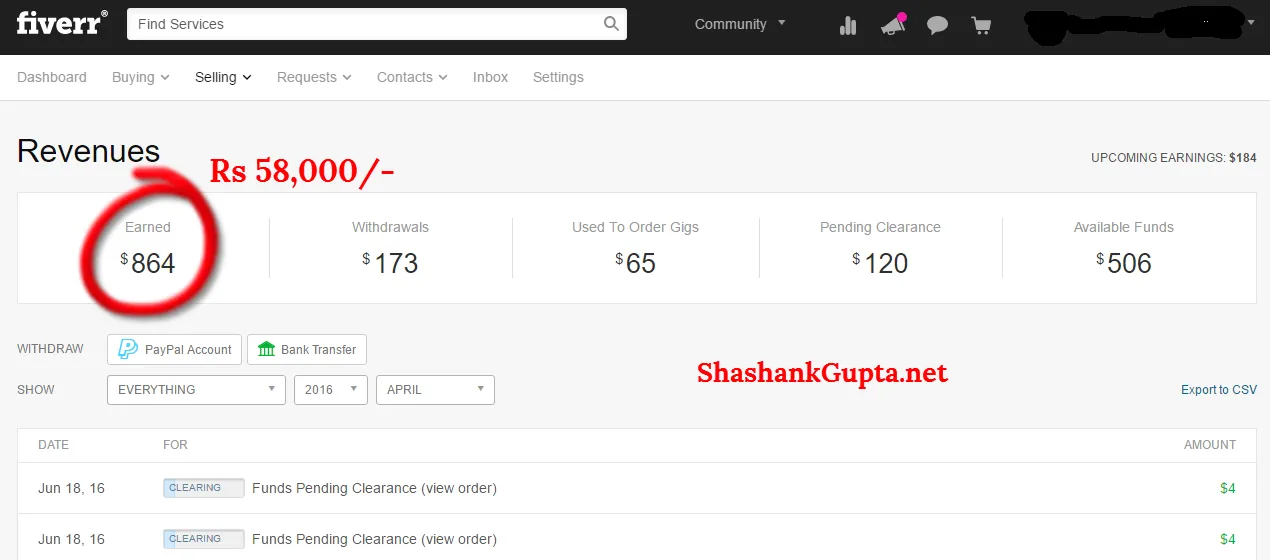Fiverr is a popular online marketplace that connects freelancers with clients seeking various digital services. Founded in 2010, it has transformed the way people approach outsourcing by allowing users to purchase or offer services starting from just $5. This unique pricing model attracted a diverse range of freelancers, including graphic designers, writers, marketers, and even musicians, providing endless possibilities for those in need of creative support.
As the gig economy continues to evolve, Fiverr has played a significant role in empowering individuals to monetize their skills. With a user-friendly interface and a plethora of categories to choose from, Fiverr has become a go-to platform for both freelancers looking to find work and clients searching for quality services at competitive prices. Over the years, the platform has grown immensely, boasting millions of services and users worldwide, making it a staple in the freelance economy.
The Fiverr Business Model

Fiverr’s business model is primarily based on a commission structure, which allows it to earn revenue while providing a platform for freelancers and clients to connect. Here’s a deeper look into how Fiverr operates:
- Service Listings: Freelancers create service listings, known as "gigs", where they outline the work they offer, set their prices, and showcase their skills. Clients can browse through these listings and hire freelancers that meet their requirements.
- Commissions: Fiverr takes a commission from each transaction made on the platform. Generally, this is around 20% of the total service fee, meaning that freelancers receive 80% of the gig price while Fiverr profits from the remaining portion.
- Upgrades and Add-Ons: Freelancers can offer additional features or services for an extra cost. Fiverr earns money when clients choose to purchase these upgrades, further enhancing their experience.
- Fiverr Pro: This premium service showcases verified professionals, allowing clients to hire top-tier talent. Fiverr charges higher fees for these services, increasing its revenue.
- Advertisements and Promotions: Fiverr also engages in advertising and promotional strategies to increase visibility for both freelancers and its own platform. When clients utilize these advertising options, Fiverr earns additional income.
In summary, Fiverr’s business model is robust and offers multiple revenue streams while creating a valuable ecosystem for both freelancers and clients. By continuously evolving and adapting to market demands, Fiverr ensures its place in the ever-growing gig economy.
Also Read This: Competitive Analysis: Diving into Dohardmoneycom with SpyFu
3. Revenue Streams for Fiverr

Fiverr has developed a robust business model that diversifies its revenue streams, ensuring a steady influx of funds while catering to a wide variety of users. Let's break down some of the primary ways Fiverr generates revenue:
- Commissions on Transactions: The biggest chunk of Fiverr's revenue comes from fees associated with transactions. Whenever a freelancer (called a "Seller") successfully completes a project, Fiverr takes a commission ranging from 5% to 20% depending on the total transaction value. This means that on every completed order, Fiverr directly benefits from a percentage of the revenue generated.
- Service Fees from Buyers: When a Buyer orders a service, they are also subject to a service fee that is based on the total cost of the order. This fee helps Fiverr cover operational costs and enhances its revenue base.
- Subscription Plans: Fiverr has introduced several subscription-based services, such as Fiverr Pro and Fiverr Business. These premium memberships offer added perks, such as enhanced visibility, personalized assistance, and access to a pool of top-notch freelancers, all contributing to the company’s bottom line.
- Sponsored Listings and Advertising: Sellers can pay for boosted visibility in search results, making their gigs more prominent to potential Buyers. This ad revenue supports both Fiverr and its Sellers in achieving greater traffic.
- Partnerships and Collaborations: Fiverr collaborates with various platforms and organizations, creating additional revenue pathways through promotional deals and joint ventures.
With this diverse range of revenue streams, Fiverr not only sustains its operations but also continues to offer valuable services to both Buyers and Sellers alike. It's a win-win situation!
Also Read This: Why Can’t I Publish My Gig on Fiverr?
4. Market Position and Competition

Fiverr has positioned itself as a leader in the gig economy, successfully carving out a niche for freelance services across various sectors. Established in 2010, it enables freelancers to offer their talents to a global audience, thus redefining how services are bought and sold online.
When considering Fiverr's market position, it’s essential to also look at its competition. Here are a few major players in the freelancing landscape:
| Platform Name | Key Features | Target Audience |
|---|---|---|
| Upwork | Hourly contracts, project-based jobs | Businesses seeking long-term relationships with freelancers |
| Freelancer | Bidding system, project auctions | Wide range of freelancers and skills |
| Guru | Workroom collaboration, portfolio showcase | Small businesses and entrepreneurs |
| PeoplePerHour | Hourlies, project-based jobs | Small businesses and startups |
While each of these competitors has its unique offerings, Fiverr's strength lies in its user-friendly interface and fixed-price gigs that attract a wide range of Buyers, from individuals to large companies.
Moreover, Fiverr’s innovative marketing strategies and consistent expansion of service offerings keep it at the forefront of the gig economy. The company's ability to adapt to market demands while offering competitive pricing solidifies its standing as a go-to platform for freelancers and Businesses alike.
Also Read This: What Freelance Medical Writers Typically Make
5. Impact of Economic Trends on Fiverr's Revenue
Fiverr, like many online platforms, is significantly influenced by broader economic trends. As we all know, the economic climate can swing dramatically—think about how the global pandemic reshaped work dynamics! Understanding how these shifts affect Fiverr's revenue helps us grasp the company’s resilience and adaptability.
One of the key trends is the rise of the gig economy. More people are moving away from traditional 9-to-5 jobs and opting for freelance opportunities. This trend is beneficial for Fiverr because it increases the number of sellers on the platform. More sellers mean a broader range of services available for buyers. In fact, Fiverr reported a rise in new sellers during economic downturns as individuals looked for ways to make ends meet.
Conversely, in a robust economy, businesses often have larger budgets for marketing and design, which can lead to an increase in Fiverr's sales. In times of economic surplus, companies are likely to invest in freelance services such as graphic design, SEO, and social media management. This creates a win-win situation for both freelancers and Fiverr, as more projects mean more revenue.
However, in tougher times, such as during a recession, Fiverr can see a dip in project listings. Freelancers might struggle to secure gigs, and businesses may tighten their budgets, opting for more cost-effective solutions. Understanding these trends helps Fiverr navigate its offerings and adapt its strategies accordingly.
Also Read This: How to Get More Orders on Fiverr: Proven Strategies for Success
6. Fiverr's Growth and Future Prospects
Looking at Fiverr's growth trajectory, it's evident that the company has carved out a niche that caters to a vast audience of freelancers and businesses alike. Since its inception in 2010, Fiverr has witnessed phenomenal growth, expanding its service offerings and user base significantly. Their unique approach of allowing freelancers to offer 'gigs' at various price points has made it accessible to everyone—whether you're an aspiring freelancer or a business on a budget.
Since going public in 2019, Fiverr has seen its stock value fluctuate, but the long-term prospects remain bright. Here are some key factors contributing to its positive outlook:
- Diversification of Services: Fiverr isn't just a one-trick pony. It continuously expands its range of services—from graphic design to voiceovers. This diversification attracts a broader client base.
- Investments in Technology: By harnessing artificial intelligence and machine learning, Fiverr aims to enhance user experience through smart searches and personalized recommendations.
- Global Reach: The platform encourages freelancers from around the world to offer their services, increasing its appeal to international clients.
- Resilience in Market Conditions: As we've discussed, Fiverr adapts well to economic fluctuations, which helps maintain growth even during challenging times.
In conclusion, while Fiverr has navigated challenges along its path, its strategy points toward continued growth. As the gig economy expands and the nature of work evolves, Fiverr is poised to be a key player in the future landscape of freelance services.
How Does Fiverr Earn Money?
Fiverr is a popular online marketplace that connects freelancers with clients seeking various services. The platform has established itself as a go-to destination for businesses and individuals looking for affordable and diverse freelance services, ranging from graphic design to digital marketing. But, how does Fiverr actually earn money?
Fiverr primarily generates revenue through the following mechanisms:
- Transaction Fees: Fiverr charges a service fee on each transaction. For buyers, this fee is generally 5% of the purchase price, while sellers incur a fee of 20% on every order they complete.
- Gigs Upgrades: Freelancers can promote their services through featured listings and other upgrades, which come at an additional cost. This allows sellers to gain more visibility, driving up their potential earnings, while Fiverr profits from the upgrade fees.
- Fiverr Business: This offering provides a suite of collaboration tools and dedicated support for teams. Companies pay a subscription fee, adding another revenue stream for Fiverr.
- Fiverr Learn: Fiverr has expanded its offerings to include educational resources for freelancers, charging for access to premium courses that help users improve their skills and increase earning potential.
- Advertising Services: Fiverr also allows businesses to promote their gigs through paid advertising options, creating an additional income avenue.
In summary, Fiverr utilizes a multi-faceted approach to generate revenue, combining transaction fees, service upgrades, subscription services, educational offerings, and advertising, all while providing a platform for freelancers to showcase their skills and services to a global audience.



